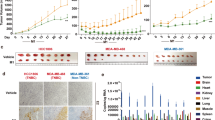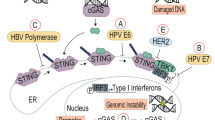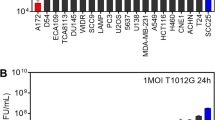Abstract
Many cancer cells refractory to radiation treatment and chemotherapy proliferate because of loss of intrinsic programmed cell death (apoptosis) regulation. Consequently, the resolution of these cancers are many times outside the management capabilities of conventional therapeutics. We now report that replication-defective Δ27 herpes simplex virus (rd Δ27) triggers apoptosis in three representative transformed human cell lines. Susceptibility to virus-induced cell death is dependent on the abundance and distribution of modified p53 protein in the tumor cells indicating specific targeting of the treatment. Primary human and mouse fibroblast cells that produce modified p53 are resistant to rd Δ27 killing but not to apoptosis induced by nonviral environmental factors. These results suggest that induction of apoptosis by nonreplicating virus is a feasible genetic therapy approach for killing human cancer cells. Our findings may have important implications in designing novel virus-based anticancer strategies in appropriate animal model systems.
This is a preview of subscription content, access via your institution
Access options
Subscribe to this journal
Receive 12 print issues and online access
$259.00 per year
only $21.58 per issue
Buy this article
- Purchase on Springer Link
- Instant access to full article PDF
Prices may be subject to local taxes which are calculated during checkout





Similar content being viewed by others
References
Kerr JF, Wyllie AH, Currie AR . Apoptosis: a basic biological phenomenon with wide-ranging implications in tissue kinetics. Br J Cancer 1972; 26: 239–257.
Cryns V, Yuan J . Proteases to die for. Genes Dev 1998; 12: 1551–1570.
Salvesen GS, Dixit VM . Caspases: intracellular signaling by proteolysis. Cell 1997; 91: 443–446.
Green DA, Evan G . A matter of life and death. Cancer Cell 2002; 1: 19–30.
Lowe SW, Lin AW . Apoptosis in cancer. Carcinogenesis 2000; 21: 485–495.
Levine AJ . p53, the cellular gatekeeper for growth and division. Cell 1997; 88: 323–331.
Prives C, Hall PA . The p53 pathway. J Pathol 1999; 187: 112–126.
Hainaut P et al. IARC Database of p53 gene mutations in human tumors and cell lines: updated compilation, revised formats and new visualisation tools. Nucleic Acids Res 1998; 26: 205–213.
Hainaut P, Hollstein M . p53 and human cancer: the first ten thousand mutations. Adv Cancer Res 2000; 77: 81–137.
Lowe SW, Ruley HE, Jacks T, Housman DE . p53-dependent apoptosis modulates the cytotoxicity of anticancer agents. Cell 1993; 74: 957–967.
Lowe SW et al. p53 status and the efficacy of cancer therapy in vivo. Science 1994; 266: 807–810.
Weinstein JN et al. An information-intensive approach to the molecular pharmacology of cancer. Science 1997; 275: 343–349.
Koyama AH, Fukumori T, Fujita M, Irie H, Adachi A . Physiological significance of apoptosis in animal virus infection. Microbes Infect 2000; 2: 1111–1117.
Aubert M, Blaho JA . Modulation of apoptosis during herpes simplex virus infection in human cells. Microbes Infect 2001; 3: 859–866.
Aubert M, O'Toole J, Blaho JA . Induction and prevention of apoptosis in human HEp-2 cells by herpes simplex virus type 1. J Virol 1999; 73: 10359–10370.
Honess RW, Roizman B . Regulation of herpesvirus macromolecular synthesis. I. Cascade regulation of the synthesis of three groups of viral proteins. J Virol 1974; 14: 8–19.
Aubert M, Rice SA, Blaho JA . Accumulation of herpes simplex virus type 1 early and leaky-late proteins correlates with apoptosis prevention in infected human HEp-2 cells. J Virol 2001; 75: 1013–1030.
Aubert M, Blaho JA . The herpes simplex virus type 1 regulatory protein ICP27 is required for the prevention of apoptosis in infected human cells. J Virol 1999; 73: 2803–2813.
Boshart M et al. A new type of papillomavirus DNA, its presence in genital cancer biopsies and in cell lines derived from cervical cancer. EMBO J 1984; 3: 1151–1157.
Schwarz E et al. Structure and transcription of human papillomavirus sequences in cervical carcinoma cells. Nature 1985; 314: 111–114.
Scheffner M, Munger K, Byrne JC, Howley PM . The state of the p53 and retinoblastoma genes in human cervical carcinoma cell lines. Proc Natl Acad Sci USA 1991; 88, 5523–5527.
Scheffner M et al. The E6 oncoprotein encoded by human papillomavirus types 16 and 18 promotes the degradation of p53. Cell 1990; 63: 1129–1136.
Munger K et al. Complex formation of human papillomavirus E7 proteins with the retinoblastoma tumor suppressor gene product. EMBO J 1989; 8: 4099–4105.
Blaho JA, Aaronson SA . Convicting a human tumor virus: guilt by association? Proc Natl Acad Sci USA 1999; 96: 7619–7621.
Howley PM . Role of the human papillomaviruses in human cancer. Cancer Res 1991; 51: 5019s–5022s.
Laimins LA . The biology of human papillomaviruses: from warts to cancer. Infect Agents Dis 1993; 2: 74–86.
Villa LL . Human papillomaviruses and cervical cancer. Adv Cancer Res 1997; 71: 321–341.
Moore AE, Sabachewsky L, Toolan HW . Culture characteristics of four permanent lines of human cancer cells. Cancer Res 1955; 15: 598–605.
Rhim JS, Cho HY, Huebner RJ . Non-producer human cells induced by murine sarcoma virus. Int J Cancer 1975; 15: 23–29.
Bacchetti S, Graham FL . Transfer of the gene for thymidine kinase to thymidine kinase-deficient human cells by purified herpes simplex viral DNA. Proc Natl Acad Sci USA 1977; 74: 1590–1594.
Kahn T, Schwarz E, zur Hausen H . Molecular cloning and characterization of the DNA of a new human papillomavirus (HPV 30) from a laryngeal carcinoma. Int J Cancer 1986; 37: 61–65.
Lu H, Taya Y, Ikeda M, Levine AJ . Ultraviolet radiation, but not gamma radiation or etoposide-induced DNA damage, results in the phosphorylation of the murine p53 protein at serine-389. Proc Natl Acad Sci USA 1998; 95: 6399–6402.
Graham FL, Smiley J, Russell WC, Nairn R . Characteristics of a human cell line transformed by DNA from human adenovirus type 5. J Gen Virol 1977; 36: 59–74.
Lowe SW, Ruley HE . Stabilization of the p53 tumor suppressor is induced by adenovirus 5 E1A and accompanies apoptosis. Genes Dev 1993; 7: 535–545.
Preston CM, Rinaldi A, Nicholl MJ . Herpes simplex virus type 1 immediate early gene expression is stimulated by inhibition of protein synthesis. J Gen Virol 1998; 79: 117–124.
Debbas M, White E . Wild-type p53 mediates apoptosis by E1A, which is inhibited by E1B. Genes Dev 1993; 7: 546–554.
Leopardi R, Roizman B . The herpes simplex virus major regulatory protein ICP4 blocks apoptosis induced by the virus or by hyperthermia. Proc Natl Acad Sci USA 1996; 93: 9583–9587.
Koyama AH, Adachi A . Induction of apoptosis by herpes simplex virus type 1. J Gen Virol 1997; 78: 2909–2912.
Koyama AH, Miwa Y . Suppression of apoptotic DNA fragmentation in herpes simplex virus type 1-infected cells. J Virol 1997; 71: 2567–2571.
Jerome KR, Tait JF, Koelle DM, Corey L . Herpes simplex virus type 1 renders infected cells resistant to cytotoxic T-lymphocyte-induced apoptosis. J Virol 1998; 72: 436–441.
Galvan V, Roizman B . Herpes simplex virus 1 induces and blocks apoptosis at multiple steps during infection and protects cells from exogenous inducers in a cell-type-dependent manner. Proc Natl Acad Sci USA 1998; 95: 3931–3936.
Leopardi R, Van Sant C, Roizman B . The herpes simplex virus 1 protein kinase US3 is required for protection from apoptosis induced by the virus. Proc Natl Acad Sci USA 1997; 94: 7891–7896.
Jerome KR et al. Herpes simplex virus inhibits apoptosis through the action of two genes, Us5 and Us3. J Virol 1999; 73: 8950–8957.
Zhou G, Galvan V, Campadelli-Fiume G, Roizman B . Glycoprotein D or J delivered in trans blocks apoptosis in SK-N-SH cells induced by a herpes simplex virus 1 mutant lacking intact genes expressing both glycoproteins. J Virol 2000; 74: 11782–11791.
Fink DJ et al. Design and application of HSV vectors for neuroprotection. Gene Therapy 2000; 7: 115–119.
Goins WF et al. Development of replication-defective herpes simplex virus vectors. Methods Mol Med 2002; 69: 481–507.
Johnson PA et al. Cytotoxicity of a replication-defective mutant of herpes simplex virus type 1. J Virol 1992; 66: 2952–2965.
Huard J et al. LacZ gene transfer to skeletal muscle using a replication-defective herpes simplex virus type 1 mutant vector. Hum Gene Therapy 1997; 8: 439–452.
Samaniego LA, Webb AL, DeLuca NA . Functional interactions between herpes simplex virus immediate-early proteins during infection: gene expression as a consequence of ICP27 and different domains of ICP4. J Virol 1995; 69: 5705–5715.
Johnson PA, Wang MJ, Friedmann T . Improved cell survival by the reduction of immediate-early gene expression in replication-defective mutants of herpes simplex virus type 1 but not by mutation of the virion host shutoff function. J Virol 1994; 68: 6347–6362.
Holmes KD et al. A multi-mutant herpes simplex virus vector has minimal cytotoxic effects on the distribution of filamentous actin, alpha-actinin 2 and a glutamate receptor in differentiated PC12 cells. J Neurovirol 2000; 6: 33–45.
Krisky DM et al. Deletion of multiple immediate-early genes from herpes simplex virus reduces cytotoxicity and permits long-term gene expression in neurons. Gene Therapy 1998; 5: 1593–1603.
Moriuchi S et al. HSV vector cytotoxicity is inversely correlated with effective TK/GCV suicide gene therapy of rat gliosarcoma. Gene Therapy 2000; 7: 1483–1490.
Samaniego LA, Neiderhiser L, DeLuca NA . Persistence and expression of the herpes simplex virus genome in the absence of immediate-early proteins. J Virol 1998; 72: 3307–3320.
Samaniego LA, Wu N, DeLuca NA . The herpes simplex virus immediate-early protein ICP0 affects transcription from the viral genome and infected-cell survival in the absence of ICP4 and ICP27. J Virol 1997; 71: 4614–4625.
Hobbs WE, Brough DE, Kovesdi I, DeLuca NA . Efficient activation of viral genomes by levels of herpes simplex virus ICP0 insufficient to affect cellular gene expression or cell survival. J Virol 2001; 75: 3391–3403.
Wu N, Watkins SC, Schaffer PA, DeLuca NA . Prolonged gene expression and cell survival after infection by a herpes simplex virus mutant defective in the immediate-early genes encoding ICP4, ICP27, and ICP22. J Virol 1996; 70: 6358–6369.
Lomonte P, Everett RD . Herpes simplex virus type 1 immediate-early protein Vmw110 inhibits progression of cells through mitosis and from G(1) into S phase of the cell cycle. J Virol 1999; 73: 9456–9467.
Hobbs II WE, DeLuca NA . Perturbation of cell cycle progression and cellular gene expression as a function of herpes simplex virus ICP0. J Virol 1999; 73: 8245–8255.
DeLuca NA, Courtney MA, Schaffer PA . Temperature-sensitive mutants in herpes simplex virus type 1 ICP4 permissive for early gene expression. J Virol 1984; 52: 767–776.
DeLuca NA, McCarthy AM, Schaffer PA . Isolation and characterization of deletion mutants of herpes simplex virus type 1 in the gene encoding immediate-early regulatory protein ICP4. J Virol 1985; 56: 558–570.
DeLuca NA, Schaffer PA . Activation of immediate-early, early, and late promoters by temperature- sensitive and wild-type forms of herpes simplex virus type 1 protein ICP4. Mol Cell Biol 1985; 5: 1997–1208.
Knipe DM et al. Molecular genetics of herpes simplex virus. VI. Characterization of a temperature-sensitive mutant defective in the expression of all early viral gene products. J Virol 1981; 38: 539–547.
Preston CM . Control of herpes simplex virus type 1 mRNA synthesis in cells infected with wild-type virus or the temperature-sensitive mutant tsK. J Virol 1979; 29: 275–284.
Kirn D, Martuza RL, Zwiebel J . Replication-selective virotherapy for cancer: biological principles, risk management and future directions. Nat Med 2001; 7: 781–787.
Ganly I et al. A phase I study of Onyx-015, an E1B attenuated adenovirus, administered intratumorally to patients with recurrent head and neck cancer [published erratum appears in Clin Cancer Res 2000 May;6(5):2120]. Clin Cancer Res 2000; 6: 798–806 (2000).
Khuri FR et al. A controlled trial of intratumoral ONYX-015, a selectively-replicating adenovirus, in combination with cisplatin and 5-fluorouracil in patients with recurrent head and neck cancer [see comments]. Nat Med 2000; 6: 879–885.
Markert JM et al. Conditionally replicating herpes simplex virus mutant, G207 for the treatment of malignant glioma: results of a phase I trial. Gene Therapy 2000; 7: 867–874.
Mineta T et al. Attenuated multi-mutated herpes simplex virus-1 for the treatment of malignant gliomas. Nat Med 1995; 1: 938–943.
Andreansky SS et al. The application of genetically engineered herpes simplex viruses to the treatment of experimental brain tumors. Proc Natl Acad Sci USA 1996; 93: 11313–11318.
Chou J, Kern ER, Whitley RJ, Roizman B . Mapping of herpes simplex virus-1 neurovirulence to gamma 134.5, a gene nonessential for growth in culture. Science 1990; 250: 1262–1266.
Raj K, Ogston P, Beard P . Virus-mediated killing of cells that lack p53 activity. Nature 2001; 412: 914–917.
Puck T, Marcus P, Cieciura SJ . Clonal growth of mammalian cells in vitro. J Exp Med 1956; 103: 273–284.
Post LE, Roizman B . A generalized technique for deletion of specific genes in large genomes: alpha gene 22 of herpes simplex virus 1 is not essential for growth. Cell 1981; 25: 227–232.
Yasumura Y, Kawakita Y . Nippon Rinsho 1963; 21: 1209.
Spector DJ . The pattern of integration of viral DNA sequences in the adenovirus 5-transformed human cell line 293. Virology 1983; 130: 533–538.
Hughes Jr RG, Munyon WH . Temperature-sensitive mutants of herpes simplex virus type 1 defective in lysis but not in transformation. J Virol 1975; 16: 275–283.
Soliman TM, Sandri-Goldin RM, Silverstein SJ . Shuttling of the herpes simplex virus type 1 regulatory protein ICP27 between the nucleus and cytoplasm mediates the expression of late proteins. J Virol 1997; 71: 9188–9197.
Acknowledgements
These studies were supported by a grant from the NIH (AI38873).
Author information
Authors and Affiliations
Rights and permissions
About this article
Cite this article
Aubert, M., Blaho, J. Viral oncoapoptosis of human tumor cells. Gene Ther 10, 1437–1445 (2003). https://doi.org/10.1038/sj.gt.3302004
Received:
Accepted:
Published:
Issue Date:
DOI: https://doi.org/10.1038/sj.gt.3302004
Keywords
This article is cited by
-
The interplay between human herpes simplex virus infection and the apoptosis and necroptosis cell death pathways
Virology Journal (2016)
-
Early passage neonatal and adult keratinocytes are sensitive to apoptosis induced by infection with an ICP27-null mutant of herpes simplex virus 1
Apoptosis (2013)
-
Effect of a caspase inhibitor, zVADfmk, on the inhibition of breast cancer cells by herpes simplex virus type 1
Cancer Gene Therapy (2011)
-
Herpes simplex virus blocks apoptosis by precluding mitochondrial cytochrome c release independent of caspase activation in infected human epithelial cells
Apoptosis (2007)
-
Widespread intratumoral virus distribution with fractionated injection enables local control of large human rhabdomyosarcoma xenografts by oncolytic herpes simplex viruses
Cancer Gene Therapy (2005)



